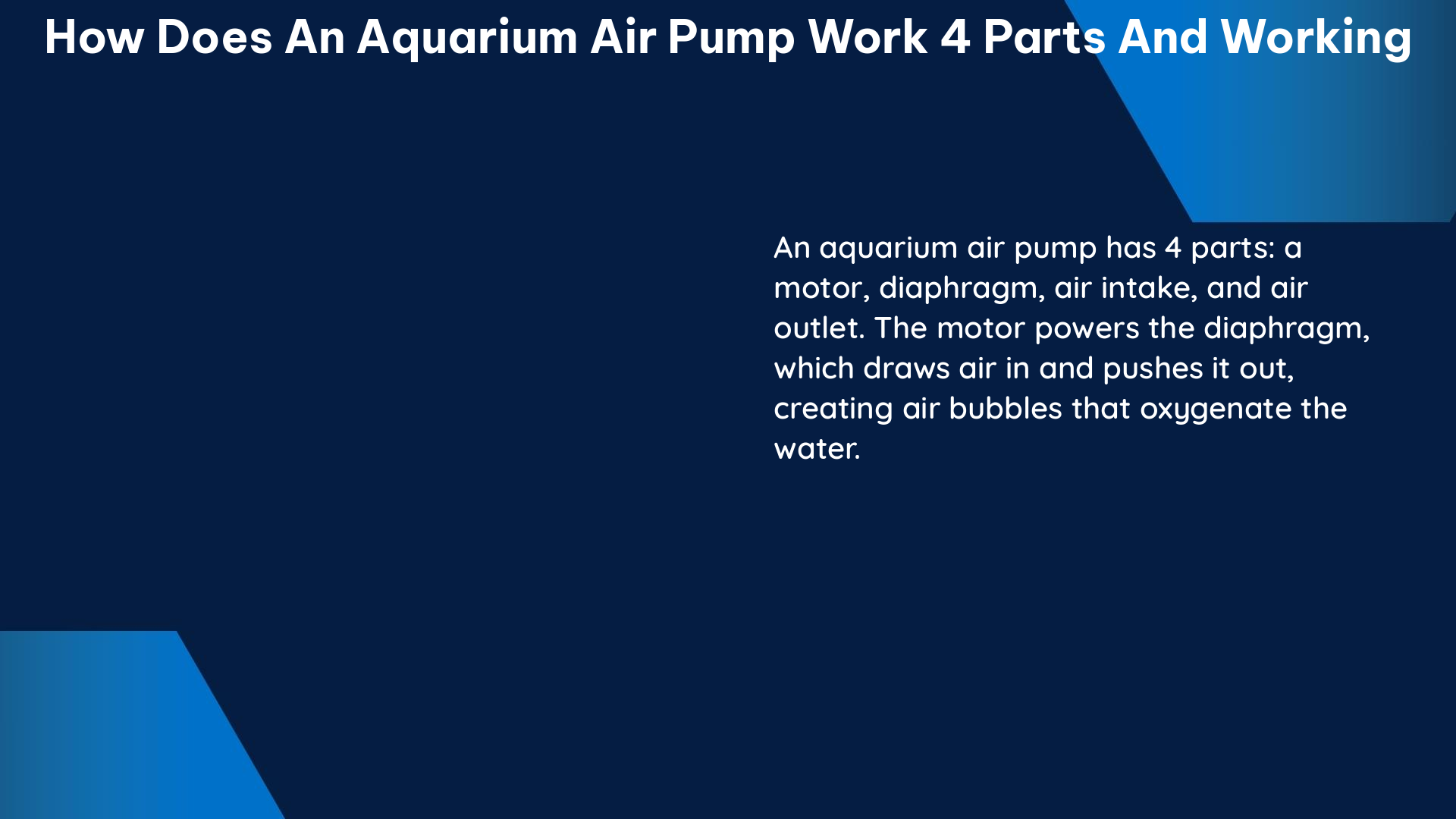An aquarium air pump is a crucial component in maintaining a healthy and thriving aquatic ecosystem. It plays a vital role in ensuring that the fish and other aquatic inhabitants have sufficient oxygen to breathe and that the water surface is agitated, allowing for the exchange of carbon dioxide and oxygen. In this comprehensive guide, we will delve into the four main parts of an aquarium air pump and explore how they work together to create a well-oxygenated and balanced environment for your aquatic life.
1. Air Pump
The air pump is the heart of the aquarium air pump system. It is an electrically-powered device that uses a diaphragm or piston mechanism to draw in air from the surrounding environment and then forcefully expel it through the airline tubing. The output of air pumps is typically measured in gallons per hour (GPH), which indicates the volume of air the pump can move in an hour.
The air pump’s performance is influenced by several factors, including:
- Power Consumption: Air pumps can vary in their power consumption, ranging from as low as 2 watts for smaller models to 10 watts or more for larger, high-output pumps.
- Noise Level: Air pumps can produce varying levels of noise, with some models designed to be quieter than others. The noise level is often measured in decibels (dB).
- Depth Rating: Air pumps are designed to operate at different depths, with some models capable of functioning at depths of up to 6 meters (20 feet) or more.
- Airflow Rate: The airflow rate, measured in liters per minute (L/min) or gallons per hour (GPH), determines the volume of air the pump can deliver to the aquarium.
- Pressure Rating: The pressure rating, measured in kilopascals (kPa) or pounds per square inch (PSI), indicates the maximum pressure the air pump can generate.
2. Airline Tubing

The airline tubing is a flexible, hollow hose that connects the air pump to the aquarium equipment or ornament. It serves as the conduit for the air flow, transporting the air from the pump to the desired destination within the aquarium.
The key characteristics of airline tubing include:
- Diameter: Aquarium air pump tubing typically ranges from 2 to 6 millimeters (mm) in diameter, with 4 mm being a common size.
- Material: The tubing is usually made of flexible, durable materials such as vinyl or silicone, which can withstand the aquarium environment.
- Length: The length of the tubing can vary depending on the size of the aquarium and the placement of the air pump and equipment.
- Kink Resistance: High-quality airline tubing is designed to be kink-resistant, ensuring uninterrupted air flow.
3. Check Valve
The check valve is an optional, but highly recommended, accessory for an aquarium air pump system. Its primary function is to prevent water from flowing back into the air pump when the pump is turned off or loses power.
The key features of a check valve include:
- Unidirectional Flow: The check valve allows air to flow in only one direction, from the air pump to the aquarium, preventing backflow.
- Pressure Rating: Check valves are designed to withstand a certain amount of pressure, typically ranging from 0.01 to 0.05 MPa (1.5 to 7.3 PSI).
- Material: Check valves are often made of durable materials such as plastic or metal to withstand the aquarium environment.
- Inline or Inline-Barbed Design: Check valves can be designed to be installed inline with the airline tubing or with barbed fittings for a secure connection.
4. Aquarium Equipment or Ornament
The final destination of the air flow from the air pump is the aquarium equipment or ornament. This can include a variety of devices, such as:
- Sponge Filters: These filters use the air flow to create a gentle, bubbling action that helps to trap debris and provide biological filtration.
- Bubble Decorations: Ornamental devices that create a decorative bubble display, adding visual interest to the aquarium.
- Air Stones: Porous stones that release fine bubbles, increasing surface agitation and oxygenation.
- Protein Skimmers: Air-driven devices that remove organic waste and improve water quality.
- Air-Powered Undergravel Filters: Utilize the air flow to create a gentle, upward water movement through the gravel bed.
The air flow from the pump is directed to these aquarium devices through the airline tubing, where it is then dispersed into the water, creating the desired effect, such as increased oxygenation, filtration, or decorative bubbles.
By understanding the four main parts of an aquarium air pump and how they work together, you can ensure that your aquarium maintains a healthy, well-oxygenated environment for your aquatic inhabitants to thrive.
Reference:
- What is an Aquarium Air Pump and Is It Necessary?
- How an Aquarium Air Pump Works
- Measuring Aquarium Air Pump Flow Rate
- How to Measure Aquarium Air Pump Flow Rate
- Aquarium Air Pumps: Everything You Need to Know
